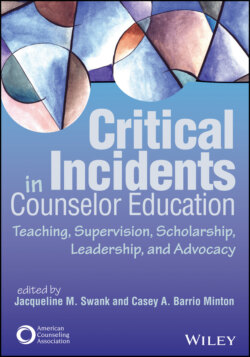Читать книгу Critical Incidents in Counselor Education - Группа авторов - Страница 40
Critical Incident Response
ОглавлениеCasey A. Barrio Minton
As a first-year faculty member, Professor P is navigating a dynamic nearly all counselor educators will navigate at some point in their careers. The academic integrity violation of focus in this case was egregious, but the author recognized that violations occur on a continuum ranging from what seem to be unintentional mistakes to clear stealing or cheating. I see two key considerations related to Professor P’s actions: deciding whether to report and coordinating responses.
Counselor educators often develop caring relationships with students they conceptualize within their developmental and cultural context. Professor P easily cued into plagiarism and approached the student with care and consideration. After exploring with the student, they issued a failing grade on the assignment and decided not to report the violation. From a dispositions perspective, students who are willing to steal or purchase assignments may also be willing to lie about their actions. Although the student may have been genuine in interactions with Professor P, they may also have intentionally misled Professor P regarding this experience.
In deciding against taking a rules ethical approach, Professor P may have inadvertently violated university policy. Many systems require faculty members to go through formal student conduct processes when assigning academic penalties, including simple grade reductions on an assignment. These policies often leave the consequences of first violations to the discretion of faculty members; however, following due process policies can protect faculty members from claims of arbitrary or unfair decisions. University reporting systems are also intended to allow the administration to detect repeat violations that warrant higher, system-level action.
Even if Professor P’s actions did not violate policy, faculty members should think carefully about the possible role of implicit bias in deciding whether to use a formal process. Professor P considered socioeconomic and age diversity as reasons not to report the incident; these and other cultural understandings of academic integrity may have been at play. It is also possible that privilege based on race, ethnicity, or other identities led the student to feel comfortable (or even entitled) to plead for an exception. These same dynamics may have led Professor P to accept the plea. Although the student’s identities are not disclosed, one could ask whether Professor P and the student would have had a similar process and come to the same conclusion if elements of identity had been changed in some way (e.g., if the student was a traditional-aged man of color). Just as there are well-documented disparities at all steps throughout the criminal justice system, systematic disparities are at play in identifying students who have cheated, reporting them, and assigning penalties.
Counselor education programs are somewhat unique within higher education systems given their programmatic approach to preparing students for practice. Professor P notified their department head of the plan to address the concern; however, there is no evidence of consultation with other faculty members regarding prior concerns related to the student, program precedent for handling academic dishonesty, or the need to activate the program’s remediation plan. Instead, Professor P took the issue on themselves, first working with the student to not report the case, then building multiple systems and structures into their courses to protect against future violations.
Although Professor P’s responsiveness is commendable, faculty members should consider working with their programs to address academic integrity on a systems level. Professor P might discuss the incident during a faculty meeting, ascertaining whether there have been previous disposition concerns about this student while also exploring the degree to which academic dishonesty is an issue within the program at large. This process could ensure mentorship for Professor P as they adapt to life as a counselor educator, pointing them to university resources, advising on helpful and not helpful responses, or even helping Professor P understand that there is already explicit coverage of plagiarism within required orientations. Professor P might have chosen a very different course of action had they discovered that the student had had similar violations in the past or had already completed mandatory academic integrity training much like what Professor P built into their courses.
If consultation with faculty reveals that academic dishonesty is a concern across students, this may point to the need for a unified plan for addressing it as a program. A collaborative discussion may help the program to set clear, fair expectations for students. If there is not a university procedure for addressing academic dishonesty, the program could develop a policy, place it in handbooks with clear ties to the ACA Code of Ethics (ACA, 2014), and address it in orientation. This may even result in an orientation assignment for a first-semester professionalism course that frees faculty members to attend to course orientation and relationships rather than plagiarism prevention in their first meetings.
All in all, Professor P expressed care and diligence in their individual response to the student and preventive steps in their courses. By converging their efforts with university policies, peer consultation, and a program-level response, Professor P can ensure fairness, clarity, and appropriate support as they continue in their new role as a counselor educator.
• • •
